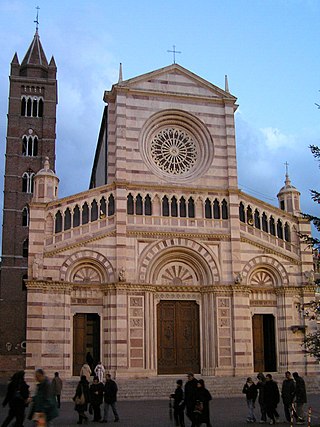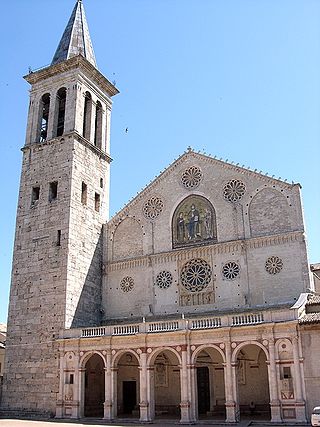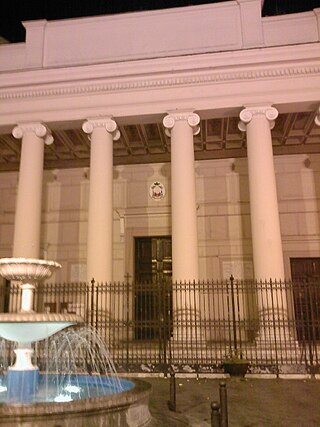Related Research Articles

The Archdiocese of Genoa is a Latin Church ecclesiastical territory or diocese of the Catholic Church in Italy. Erected in the 3rd century, it was elevated to an archdiocese on 20 March 1133. The archdiocese of Genoa was, in 1986, united with the Diocese of Bobbio-San Colombano, forming the Archdiocese of Genoa-Bobbio; however a split in 1989 renamed it the "Archdiocese of Genoa."

The Diocese of Ajaccio is a Latin Church ecclesiastical jurisdiction or diocese of the Catholic Church in France. The diocese comprises the whole of the island of Corsica.

The Diocese of Rieti is a Latin Church ecclesiastical territory or diocese of the Catholic Church in Italy. It is immediately exempt to the Holy See. Its cathedra is in St. Mary Cathedral in the episcopal see of Rieti.

The Diocese of Grosseto is a Latin Church diocese of the Catholic Church in Italy, a suffragan of the archdiocese of Siena-Colle di Val d'Elsa-Montalcino, in Tuscany. Its current bishop is Giovanni Roncari, OFMCap.

The Archdiocese of Pisa is a Latin Church metropolitan see of the Catholic Church in Pisa, Italy. It was founded in the 4th century and elevated to the dignity of an archdiocese on 21 April 1092 by Pope Urban II. The seat of the bishop is the cathedral of the Assumption in the Piazza del Duomo.

The Diocese of Savona-Noli is a Latin diocese of the Catholic Church in northern Italy. It was historically the Diocese of Savona, from the tenth century. In 1820 the Diocese of Noli was united to the Diocese of Savona. It is a suffragan of the Archdiocese of Genoa.

The Archdiocese of Spoleto-Norcia is a Latin Church ecclesiastical territory or archdiocese of the Catholic Church in Italy. Historically, it was the Diocese of Spoleto. Elevated to the status of an archdiocese since 1821, it is a non-metropolitan see and is immediately exempt to the Holy See.

The Diocese of Tivoli is a Latin Church ecclesiastical territory or diocese of the Catholic Church in Latium, Italy, which has existed since the 2nd century. In 2002 territory was added to it from the Territorial Abbey of Subiaco. The diocese is immediately exempt to the Holy See.

The Diocese of Arezzo-Cortona-Sansepolcro is a Latin diocese of the Catholic Church. It has existed since 1986. In that year the historic diocese of Arezzo was combined with the diocese of Cortona and the diocese of Sansepolcro, the enlarged diocese being suffragan of the archdiocese of Florence.

The Roman Catholic diocese of Bobbio was an Italian bishopric which existed from 1014 until 1986. The diocese was formed from the territory of the Abbey of Bobbio.

The Diocese of Ventimiglia-Sanremo is a Latin diocese of the Catholic Church in Liguria, northern Italy. The name of the historic Diocese of Ventimiglia was changed in 1975. It was originally a suffragan diocese of the Metropolitanate of Milan up to 1806, when it was transferred to the Metropolitanate of Aix; but it has been a suffragan of the Archdiocese of Genoa since 1818.

The diocese of Teano-Calvi is a Latin diocese of the Catholic Church in Campania, southern Italy, created in 1986. It is a suffragan of the Archdiocese of Naples. The historic Diocese of Teano and diocese of Calvi Risorta were united in 1818, forming the diocese of Calvi e Teano.

The Diocese of La Spezia-Sarzana-Brugnato is a Latin diocese of the Catholic Church in Liguria, northern Italy, created in 1929. It is a suffragan of the Archdiocese of Genoa.

The Diocese of Acerra is a Latin diocese of the Catholic Church in Campania, southern Italy, eight miles east of Naples, in the area once called Terra Laboris (Liburia). It has existed since the 11th century. It is a suffragan of the Archdiocese of Naples.

The Diocese of Anagni-Alatri is a Latin Church ecclesiastical territory or diocese of the Catholic Church in Lazio, Italy. It has existed in its current form since 1986. In that year the Diocese of Alatri was united to the historical Diocese of Anagni. The diocese is immediately exempt to the Holy See.
The Diocese of Mariana and Acci or Diocese of Accia and Mariana was a Roman Catholic ecclesiastical territory. It is now a titular see.

The Diocese of Accia was a Roman Catholic bishopric on the island of Corsica. It is now a titular diocese. The diocese was located in the town of Accia in the interior region of Haute-Corse, which was destroyed and from which only some ruins remain. Established in 824 AD it was merged with the Diocese of Mariana in 1554. In 1570 the Bishop of Mariana and Accia moved his seat to Bastia.
The Diocese of Mariana in Corsica was a Roman Catholic ecclesiastical territory in Mariana, Corsica, in the north-eastern corner of the island. In 1563 the diocese was united with the Diocese of Acci(a) to form the Diocese of Accia and Mariana. Both dioceses were poor and had lost population. Mariana had been abandoned and its bishop lived in Bastia to the north, the seat of the civil government of the island. The Cathedral sat alone near the banks of the River Golo some three miles from the sea, in the midst of fields.
The Diocese of Sagone was a Roman Catholic diocese in France, located in the city of Sagone, Corsica. In 1801, it was suppressed, and its Catholic population assigned to the Archdiocese of Ajaccio.

The Diocese of Nebbio was a Roman Catholic diocese located in the town of Saint-Florent in Corsica. The Cathedral is on a low hill one mile from the port of Saint-Florent. In the Medieval period the Bishop of Nebbio was also the temporal lord of nearly all the lands in his diocese. In 1667, Nebbio was completely abandoned and the bishop lived in Saint-Florent, a town of about 200 inhabitants, under the dominion of the Republic of Genoa. The diocese had some 22 places. The Cathedral Chapter had two dignities, the Archdeacon and the Provost, and three Canons. In 1770 the diocese was under the dominion of the King of France, and Saint-Fleur had about 600 inhabitants. The Chapter of the Cathedral still existed, with two dignities and six Canons.
References
- ↑ "Diocese of Aleria". Catholic-Hierarchy.org . David M. Cheney. Retrieved 29 February 2016.[ self-published source ]
- 1 2 3 4 5 6 7 8 9 10 11 12 13 14 15 16 17 18 "Titular Episcopal See of Aléria" GCatholic.org. Gabriel Chow. Retrieved February 29, 2016
- ↑ Richards, Jeffrey (1980). Consul of God: The Life and Times of Gregory the Great. London, Boston: Routledge & Kegan Paul. p. 237. ISBN 0-7100-0346-3.
- ↑ Gregory I, Epistolarum Liber I, no. 78 (sometimes numbered 76), in: J. P. Migne (ed.), Patrologiae Latinae Tomus LXXVII (Paris 1862), pp. 532-533.
- ↑ Gregory (Epistles I, no. 80; Migne, p. 533) writes to the clergy and nobility of Corsica: Gregorius clero et nobilibus Corsicae a paribus. Etsi vos multo iam tempore sine pontifice esse Dei ecclesiae non doletis, nos tamen de eius regimine cogitare et suscepti cura compellit officii.... He announces that he is sending a second bishop to work with Bishop Leo, Martinum fratrem et coepiscopum nostrum ibidem cardinalem constituere sacerdotem, Leoni vero fratri et coepiscopo nostro operam eius visitationis iniungere. The special authority of the Pope was necessary since both bishops were working in dioceses which were not their own.
- ↑ Kehr, p. 467, no. 13.
- ↑ Kehr, p. 468, no. 14, from the "Life of Leo IV" in the Liber Pontificalis (ed. Duchesne, II, p. 126).
- ↑ Kehr, p. 469, no. 18.
- ↑ Kehr, p. 469, no. 19-20.
- ↑ Kehr, p. 469, no. 21.
- ↑ Ritzler, V, p. 76, note 1.
- ↑ Ritzler, VI, p. 74, note 1.
- ↑ Annuario Pontificio 2013 (Libreria Editrice Vaticana 2013 ISBN 978-88-209-9070-1), p. 829
- ↑ Bishop Petrus of Aleria in Corsica was ordered by Pope Gregory I in AD 596 to consecrate a basilica church with its baptistery in the village of Nigeuno. J.P. Migne (ed.), Patrologiae latinae Tomus LXXVII (Paris 1862), p. 813 (Epistolarum Liber VI no. xxii.) Ughelli, p. 502. Cappelletti, p. 328. P. Jaffé, Regesta pontificum Romanorum I editio altera (Leipzig 1885), p. 171 no. 1402. A second letter, of September 597: Jaffe, no. 1488.
- ↑ Bishop Bonosus subscribed his name at the Lateran Synod of Pope Martin I in 649, immediately after Opportunus of Pisa and Donatus of Mariana. Ughelli, p. 502. J. D. Mansi (ed.) Sacrorum Conciliorum nova et amplissima collectio edito novissima, Tomus decimus (10) (Florence: A. Zatta 1764), p. 867. Cappelletti, p. 329. Ughelli, followed blindly by Cappelletti, put the Synod in 646, but Pope Martin was not pope until 649.
- ↑ Giovanni Benedetto Mittarelli (1758). Annales camaldulenses ordinis Sancti Benedicti (in Latin). Vol. Tomus tertius (III). Venice: J. B. Pasquali. p. 177. Pope Gelasius II was just dead when the Council of Mariana took place. Cappelletti, pp. 329-330. Kehr, pp. 472-473.
- ↑ Kehr, p. 467, no. 12, from the "Vita Sisinii" in the Liber Pontificalis (ed. Duchesne, I, p. 388). It is conjectured that there was only one bishop in Corsica at that time.
- ↑ Nicolaus Fortiguerra was a native of Siena. Ughelli, p. 502. Cappelletti, p. 331. Gams, p. 765.
- ↑ Fr. Bartolomeo was a Dominican, according to Ughelli, p. 502.
- ↑ Orlandini was removed from office because he was a follower of Louis the Bavarian, who had been excommunicated by Pope John XXII in 1324. In 1328 Louis had been crowned Emperor in Rome (Ughelli says it was by Orlandini), and had appointed an anti-pope "Nicholas V". Ughelli, p. 503. Eubel, I, p. 82, with n. 2.
- ↑ Galgano was a Florentine, provided in place of Orlandini by Pope John XXII. He was transferred to the diocese of Cefalonia in 1342, where he died in 1351. Cappelletti, p. 331-332. Eubel, I, p. 82.
- ↑ In 1345 Arcumbaldi was transferred to the diocese of Segni. Cappelletti, p. 332. Eubel, I, p. 82.
- 1 2 3 Eubel, I, p. 82.
- ↑ Cappelletti, p. 332. Eubel, I, p. 82.
- ↑ Salvinus had been a Canon (of Nebbio?) Ughelli, p. 503. Cappelletti, p. 332. Eubel, I, p. 82.
- ↑ Bartholomaeus had been Archdeacon of Volterra. His episcopal appointment came from Pope Innocent VII of the Roman Obedience. He participated in the Council of Pisa in 1409. Cappelletti, p. 332. Eubel, I, p. 82.
- ↑ Ottobrino was a native of Genoa. His episcopal appointment came from Pope John XXIII of the Pisitan-Avignon Obedience. Eubel, I, p. 82.
- ↑ Ioannes Leonis: Ughelli, p. 503. Cappelletti, p. 333, who reports that he was elected Bishop of Larino a month after he was appointed to Aleria. He is ignored in Eubel, I, p. 82; in Eubel, II, p. 172, it is reported that he was approved by the Pope as Bishop of Larino on 16 September 1440.
- ↑ Ambrogio was a nephew of Bishop Giovanni d'Omessa of Mariana, Corsica. Cappelletti, p. 332.
- ↑ "Bishop Giovanni Andrea de Bussi (Bossi)". Catholic-Hierarchy.org . David M. Cheney. Retrieved 29 February 2016.[ self-published source ]
- ↑ "Ardicino Cardinal della Porta (Jr.)". Catholic-Hierarchy.org . David M. Cheney. Retrieved 29 February 2016.[ self-published source ] Della Porta was created Cardinal-Priest of Santi Giovanni e Paolo by Pope Innocent VIII on 9 March 1489; he was also Apostolic Administrator of Olomouc (Bohemia) (1489–1493). Eubel, II, pp. 20, 85, 206 with note 5.
- ↑ A native of Genoa, Girolamo Pallavicini was the nephew of Cardinal Antoniotto Pallavicini. He did not attend the Lateran Council of 1512, but appointed a procurator, his brother Giovanni Battista Pallavicini, Bishop of Cavaillon. Cappelletti, p. 336. Eubel, II, p. 85.
- ↑ Cybo was Cardinal-Deacon of S. Maria in Domnica (1517.06.26 – 1550.02.28), also Apostolic Administrator of Marseille (France) (1517.05.11 – 1530.01.12), also Apostolic Administrator of Ventimiglia (Italy) (1519.07.27 – 1519.08.08); and Bourges (France).
- ↑ "Innocenzo Cardinal Cibo (Cybo)". Catholic-Hierarchy.org . David M. Cheney. Retrieved 29 February 2016.[ self-published source ]
- ↑ Francesco Pallavicini had been a Canon of the Cathedral of Genoa. He was appointed Notarius causarum palatii Apostolici. In 1542 he was made Deputy of the Fabric of St. Peter's. Eubel, III, p. 102 with notes 4 and 5.
- ↑ A native of Genoa, Pietro Pallavicini, a Doctor in utroque iure (Civil and Canon Law) received a dispensation to be ordained because of his youth. He was a Canon of the Vatican Basilica in succession to his uncle Carlo Pallavicini until 1552. He was also Abbot Commendatory of the monastery of S. Andrea de Sexto in Genoa. Eubel, III, p. 102 with note 6.
- ↑ Sauli had previously been Superior General of Clerics Regular of Saint Paul (Barnabites) (1567.04.09 – 1570.02.10), and was later Bishop of Pavia (Italy) (1591.10.30 – death 1592.10.11). Sauli was named a Saint of the Roman Catholic Church in 1904, as the French parliament was debating the disestablishment of religious organizations in France. See: Mathilde Guilbaud, "La loi de séparation de 1905 ou l’impossible rupture," Revue d'histoire du XIXe siècle 28 (2004) pp. 163-173.
- ↑ Belmosto was a priest of the diocese of Genoa, and a Doctor in utroque iure (Civil and Canon Law); he was Abbot Commendatory of the monastery of S. Maria de Matina. He needed a dispensation for consecration, since he had only been in Holy Orders for five months when named bishop. Eubel, III, p. 102 with note 8. "Ottavio Cardinal Belmosto (Belmusti)". Catholic-Hierarchy.org . David M. Cheney. Retrieved 29 February 2016.[ self-published source ] Belmosto was later Bishop of Pavia (Italy) (1591.10.30 – death 1592.10.11) and was later created Cardinal-Priest of S. Carlo ai Catinari (1616.10.17 – death 1618.11.16)
- ↑ "Domenico Cardinal Rivarola". Catholic-Hierarchy.org . David M. Cheney. Retrieved 29 February 2016.[ self-published source ] Rivarola was later Metropolitan Archbishop of Nazareth–Canne–Monteverde in Barletta (Italy) (1609.03.30 – death 1627.01.03), created Cardinal-Priest of S. Martino ai Monti (1611.09.12 – death 1627.01.03)
- ↑ "Bishop Giovanni Sauli (Scali, Sacchi), O.P." Catholic-Hierarchy.org . David M. Cheney. Retrieved 29 February 2016.[ self-published source ]
- ↑ "Bishop Giovanni Francesco Murta (de Mirto), C.R." Catholic-Hierarchy.org . David M. Cheney. Retrieved 29 February 2016.[ self-published source ]
- ↑ Raggi was already Cardinal-Priest of Sant'Agostino (1642.02.10 – 1643.12.31)
- ↑ Durazzo was born in Genoa, and obtained a doctorate in utroque iure (Civil and Canon Law) from the University of Pisa (1663). He was Archdeacon of the Church of Genoa. He was approved as bishop of Aleria on 25 June 1674 and consecrated in Rome by Cardinal Camillo Massimi on 1 July 1674. He was transferred to the diocese of Mariana et Acci on 19 May 1704 (1704 – 1706). Ritzler, V, p. 76 with note 3.
- ↑ Raggi was born in Genoa, and served as Provost of the College of S. Paolo in Genoa. He died in Aleria on 20 September 1712. Ritzler, V, p. 76 with note 4.
- ↑ Fornari was born in Genoa, and obtained a doctorate in utroque iure (Civil and Canon Law) from the University of Bologna (1697). He was named a Protonotary Apostolic in 1700, and became a Consultor of the Office of the Holy Inquisition in Genoa in 1702. He was consecrated a bishop in Rome on 5 February 1713 by Cardinal Ferdinando de Abdua. He was transferred to the diocese of Albenga (Italy) (20 Feb 1715 – Dec 11 1730). He was later Titular Bishop of Attalea in Lydia (11 Dec 1730 – ?). Ritzler, V, pp. 75 and 76 with note 5.
- ↑ Saluzzo was transferred to the diocese of Mariana et Acci (1720 – death 1747)
- ↑ Curlo was born in Genoa. He taught philosophy and theology at the Sapienza in Rome. He was twice Provincial of the Roman Province of his Order. He was dispensed from the vow which members of his Order took, not to accept a dignity. He was consecrated bishop in Rome on 2 July 1741 by Pope Benedict XIV. He died on 27 December 1749. Ritzler, VI, p. 74 with note 2.
- ↑ Ritzler, VI, p. 74 with note 3.
- ↑ De Guernes was born in the diocese of Limoges. He held a batchelor degree in theology and a licenciate in Civil and Canon Law. He was Vicar-General of the diocese of Riez, and then Vicar-General of Auxerre. Ritzler, VI, p. 74 with note 4.